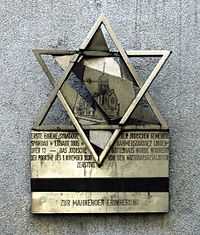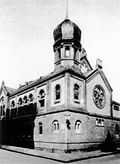Spandau Synagogue
| Spandau Synagogue | |
|---|---|
|
Spandau Synagogue on the corner of Lindenufer and Kammerstraße, built in 1894–1895 and destroyed in 1938. The ruins were removed, probably in 1942.[1] | |
| Basic information | |
| Location | 12 Lindenufer[1] (corner of Lindenufer and Kammerstraße), Spandau, Berlin, Germany |
| Affiliation | Orthodox Judaism |
| Municipality | Spandau, Berlin |
| Year consecrated | 1895 |
| Status | Destroyed |
| Leadership | Rabbi Arthur Löwenstamm (from 1917 to 1938) |
| Architect(s) | Cremer & Wolffenstein[1] |
| Completed | 1895 |
| Capacity | 296 seats[1] |
Spandau Synagogue was a synagogue at 12 Lindenufer[1] in Spandau, Berlin. It was also known as Spandauer Vereinssynagoge[2] (i.e. Spandau private synagogue).
The synagogue was built in 1894–1895[1] and was destroyed on 9 November 1938 (Kristallnacht) when it was set on fire.[3][4] The ruins were removed, probably in 1942.[1]
History

In 1844 there were only six Jewish families in Spandau. They held services in rented rooms in local restaurants. Late in 1894 Berlin-based architects Wilhelm Albert Cremer and Richard Wolffenstein began the construction of the community's first and only synagogue, which was dedicated by the Spandau Jewish community on 15 September 1895 in the presence of Spandau's Mayor, Wilhelm Georg Koeltze (1852–1939), and other local dignatories. The building, on a street corner with facades on two sides, was crowned by an octagonal tower.[5]
On 6 December 1916 Arthur Löwenstamm became the synagogue's first permanent rabbi. He took up his duties on 1 April 1917 and continued until the autumn of 1938.
Memorials
At the initiative of the Spandau Borough Council, a memorial tablet was unveiled in 1988 on the site of the former synagogue.[6] A memorial plaque was placed on the pavement, in front of Löwenstamm's former home at Feldstraße 11, in Spandau, on 9 November 2005.
Memorial to the Jews from Spandau who were deported and murdered
_Synagoge_Spandau.jpg)
_Synagoge_Spandau.jpg)

In a park opposite the site of the former synagogue there is a memorial, designed by Ruth Golan and Kay Zareh[7] and installed in 1988, to the Jews from Spandau who were deported and murdered by the Nazis.
The memorial symbolises a building and tower that have been violently torn down, with one now behind the other. Through the split tower an eternal light shines as a symbol of remembrance of the dead.[8]
In 2012, the memorial was extended by a wall on which the names of deported and murdered Jews from Spandau are recorded. This was also designed by Ruth Golan and Kay Zareh. The project was supported by the Evangelical Church of Spandau district, the district office of Spandau and private sponsors. The memorial was inaugurated on 9 November 2012, the seventy-fourth anniversary of Kristallnacht.
The German inscription on the memorial reads: "This memorial commemorates the suffering of Spandau's citizens of Jewish faith during the Terror of the National Socialists. Not far from this point, at Lindenufer 12, stood the Jewish house of worship, which was destroyed in 1938."
The memorial is located on Lindenufer (Altstadt Spandau) at ♁ 52 ° 32 '13 " N , 13 ° 12 '28 " E.
Footnotes and references
- ↑ 1.0 1.1 1.2 1.3 1.4 1.5 1.6 "Mahnmal "Flammenwand" – Synagogen Berlins (Memorial "Wall of Flame" – Berlin's synagogues)". Edition Luisenstadt. 7 October 2009. Retrieved 9 April 2013.
- ↑ "Monument Spandauer Vereinssynagoge". TracesofWar.com. Retrieved 9 May 2014.
- ↑ Alois Kaulen and Joachim Pohl (1988). Juden in Spandau vom Mittelalter bis 1945. Edition Hentrich Berlin. pp. 108–109.
- ↑ Frederic Zeller, who was then a Jewish teenager in Spandau, gives an eyewitness account of the burning of the synagogue in his memoir: Frederic Zeller (1989). When Time Ran Out: Coming of Age in the Third Reich. London: W H Allen. pp. 188–189. ISBN 0 491 03614 0.
- ↑ Harold Hammer-Schenk (1997). Synagogen, in Berlin und seine Bauten, Teil VI, Sakralbauten (Synagogues in Berlin and its Buildings, Part VI, Religious Buildings). Berlin: Ernst & Sohn. ISBN 3-433-01016-1.
- ↑ "Arthur Löwenstamm". German Wikipedia. Retrieved 1 April 2013.
- ↑ Berlinische Galerie and The Senator for Construction and Housing (ed.) (1989). Gedenken und Denkmal / Entwürfe zur Erinnerung an die Deportation und Vernichtung der jüdischen Bevölkerung Berlins (Commemoration and Memorial / designs to commemorate the deportation and extermination of the Jewish population of Berlin). Catalogue of the exhibition (4 November 1988 to 8 January 1989) in the Berlinische Galerie. p. 83.
- ↑ Berlinische Galerie and The Senator for Construction and Housing (ed.) (1989). Gedenken und Denkmal / Entwürfe zur Erinnerung an die Deportation und Vernichtung der jüdischen Bevölkerung Berlins (Commemoration and Memorial / designs to commemorate the deportation and extermination of the Jewish population of Berlin). Catalogue of the exhibition (4 November 1988 to 8 January 1989) in the Berlinische Galerie. p. 28.
External links
![]() Media related to Synagoge Spandau at Wikimedia Commons
Media related to Synagoge Spandau at Wikimedia Commons
Coordinates: 52°32′13″N 13°12′28″E / 52.53694°N 13.20778°E
